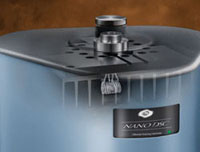TA Instruments Nano DSC III

Nano-DSC III is a differential scanning calorimetry (DSC), measures the difference in the heat required to increase the temperature of a sample and its reference. This techinque is appliable for studies of phase transition, midpoint of the thermal unfolding (Tm) and such transitions involve energy changes (ΔH) or heat capacity changes (ΔCp).
Please refer to User's Manual to learn more about N-DSC III.
 Important Notification:
Important Notification:
![]() * (2017-4-12) Nano DSC 3 is shut down due to pressure problems.
* (2017-4-12) Nano DSC 3 is shut down due to pressure problems.
![]() * (2015-9-8) Nano DSC 3 is shut down due to pressure leakage and baseline problems.
* (2015-9-8) Nano DSC 3 is shut down due to pressure leakage and baseline problems.
![]() * (2015-8-24) Please use "Constant pressure" function to set up your DSC experiments.
* (2015-8-24) Please use "Constant pressure" function to set up your DSC experiments.
![]() * (2015-8-15) Nano DSC 3 is shut down due to pressure leakage and baseline problems.
* (2015-8-15) Nano DSC 3 is shut down due to pressure leakage and baseline problems.
![]() * (2015-6-23) Nano DSC 3 is shut down due to pressure leakage and control PC problems.
* (2015-6-23) Nano DSC 3 is shut down due to pressure leakage and control PC problems.
![]() * (2015-3-27) Nano DSC 3 is ready for reservation .
* (2015-3-27) Nano DSC 3 is ready for reservation .
![]() * (2015-3-20) Nano DSC 3 is under maintenance due to decreasing pressure during scans.
* (2015-3-20) Nano DSC 3 is under maintenance due to decreasing pressure during scans.
![]() * (2015-3-2) NanoAnalyze is not available on the control PC. Please install the sofeware on your own computer. NanoAnalyze 3.3.0 can be downloaded on TA instruments website.
* (2015-3-2) NanoAnalyze is not available on the control PC. Please install the sofeware on your own computer. NanoAnalyze 3.3.0 can be downloaded on TA instruments website.
![]() * (2015-1-14) Nano DSC 3 is ready for reservation.
* (2015-1-14) Nano DSC 3 is ready for reservation.
![]() * (2015-1-5) Nano DSC 3 is under maintenance due to unstable baselines and an extraneous peak around 80 degree. Sorry for the inconvenience. Service is called.
* (2015-1-5) Nano DSC 3 is under maintenance due to unstable baselines and an extraneous peak around 80 degree. Sorry for the inconvenience. Service is called.
* (2012-11-22) The pressure problem of Nano DSC III is resolved. The connector to the sensor was clogged because samples got through the white pressure plug. Please be careful when cleaning the sample chamber. In addition, cell clean procedures with detergent and formic acid were modified. Do not apply pressure cap.
* (2012-11-07) NanoAnalyze was upgraded to 2.3.6. Unlike previous version, sample concentrations are required before performing model fitting.
* (2012-10-31) Nano DSC III is having a pressure problem. The instrument is not available until the pressure problem is resolved.
* (2012-10-08) The "Simplified Protocol" is modified. Please refer to step 24 and 28 for loading detergent and formic acid for cell cleaning procedures.
* (2010-12-23) Nano DSC III control software was upgraded to v. 4.0.8. The software takes longer time to initiate, so please be patient. Sometimes, unpluging the internet cable may help to speed up the initiation process. In addition, pressure can not be set to "Constant". Set to "Manual" instead.
* (2010-10-25) Please set the pressure parameter to "None". The softare and hardware appeared to have problems if pressure parameter was not set to "None". The software crashes between scans.
* (2010-09-06) The new version of DSCrun no longer provides data appending option! Instead, it prompts to ask if you want to "overwrite"! Say "NO"!!
* (2010-06-25) Please leave the instrument ON if there is a reservation within 5 days.
* (2010-01-25) Your BUFFER should always be used for condition run, NOT water.
* (2009-12-31) Please set the pressure parameter of TA's degassing station to the maximum setting of 635 mmHg, which is about 0.2 atm.
* (2009-12-11) Recent crash problems were identified by TA. The problem comes from replacing the currently-executing experiment step with a different end temperature. Please avoid that by all means.
* (2009-11-11): NDSC Run was upgraded to v. 3.6.0; NanoAnalyze was upgraded to 2.0. Crash problem with "Help" option was fixed. Result overlap is now available.
 Selected Applications
Selected Applications
Sample (protein) stability Sample homogenesity Protein domain and subunit stabilities Ligand binding Membrane protein/membrane interaction
 Specification
Specification
| Short term noise level | 0.015 μWatts |
| Baseline repeatability | 0.028 μWatts |
| Operation temp. | -10 - 130℃ |
| Pressure range | 1-6 ATM |
| Scan rate | 0.1 - 2℃/min |
| Sample/reagent capacity | 1x96/384-well palte+33 vials |
| Response time | 5 sec |
| Cell Volume | 0.30 ml |
| Heat measurement type | Power compensation |
For more detail, please refer to Nano DSC III website.
 Suggested Reading:
Suggested Reading:
Nano differential scanning calorimeter getting started guide Nano DSCrun software getting started guide. NanoAnalyze software getting started guide. Cooper A, Nutley MA, and Wadood A 2001, Differential scanning microcalorimetry In Protein-Ligand Interactions: hydrodynamics and calorimetry, Harding SE, Chowdhry BZ (eds). Oxford University Press; pp.287-318.

